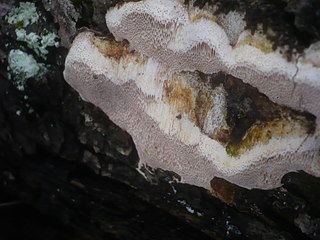
Acrossocheilus is a genus of ray-finned fishes in the family Cyprinidae, native to freshwater in China, Taiwan, Laos, and Vietnam. They are fairly small, no more than 30 cm (1 ft) in standard length.

Cymbidium, commonly known as boat orchids, is a genus of evergreen flowering plants in the orchid family Orchidaceae. Orchids in this genus are epiphytic, lithophytic, terrestrial or rarely leafless saprophytic herbs usually with pseudobulbs. There are usually between three and twelve leaves arranged in two ranks on each pseudobulb or shoot and lasting for several years. From one to a large number of flowers are arranged on an unbranched flowering stem arising from the base of the pseudobulb. The sepals and petals are all free from and similar to each other. The labellum is significantly different from the other petals and the sepals and has three lobes. There are about fifty-five species and sixteen further natural hybrids occurring in the wild from tropical and subtropical Asia to Australia. Cymbidiums are well known in horticulture and many cultivars have been developed.

Michelia is a historical genus of flowering plants belonging to the Magnolia family (Magnoliaceae). The genus included about 50 species of evergreen trees and shrubs, native to tropical and subtropical south and southeast Asia (Indomalaya), including southern China. Today it is regarded as a synonym of Magnolia.
Sinocyclocheilus is a genus of freshwater fish in the family Cyprinidae endemic to China, where only found in Guangxi, Guizhou and Yunnan. Almost all of its species live in or around caves and most of these have adaptions typical of cavefish such as a lack of scales, lack of pigmentation and reduced eyes. Several species have an unusual hunchbacked appearance and some of the cave-dwellers have a "horn" on the back, the function of which is unclear. In contrast, the Sinocyclocheilus species that live aboveground, as well as a few found underground, show no clear cavefish adaptions. They are relatively small fish reaching up to 23 cm (9.1 in) in length. The individual species have small ranges and populations, leading to the status of most of the evaluated species as threatened. Many species populations in the genus have yet to be evaluated by the IUCN.

Perenniporia is a cosmopolitan genus of bracket-forming or crust-like polypores in the family Polyporaceae. They are dimitic or trimitic with smooth, thick-walled basidiospores and cause a white rot in affected wood.

Triplophysa is a genus of fish in the family Nemacheilidae found mainly in and around the Qinghai-Tibet Plateau in China. Currently, the genus is a mixed assemblage of species. Some lineages have been identified and treated as subgenera, but as Wikipedia follows Fishbase for fish species these have been treated as subgenera in Wikipedia, although Kottelat and the Catalog of Fishes treat them as genera. FishBase, however, includes these in Triplophysa without specifying subgenera and treats the names given by Kottelat as synonyms.

Yunnanilus is a genus of small stone loaches that are endemic to southeastern China, especially Guangxi and Yunnan. They are found in rivers, streams and lakes; some species are restricted to caves.

Phanerochaete is a genus of crust fungi in the family Phanerochaetaceae.
Raymond C. Stevens is an American chemist and structural biologist, Founding Director of the iHuman Institute at ShanghaiTech University; Provost Professor of Biological Sciences and Chemistry, and Director of the Bridge Institute at the University of Southern California; Board of Directors, Danaher Corporation.
Lipothrixviridae is a family of viruses in the order Ligamenvirales. Thermophilic archaea in the kingdom Crenarchaeota serve as natural hosts. There are currently eleven species in this family, divided among 4 genera.

Leukocyte immunoglobulin-like receptor subfamily B member 4 is a protein that in humans is encoded by the LILRB4 gene.

Metarhizium is a genus of entomopathogenic fungi in the Clavicipitaceae family. With the advent of genetic profiling, placing these fungi in proper taxa has now become possible. Most turn out to be the asexual forms (anamorphs) of fungi in the phylum Ascomycota, including Metacordyceps spp.

Icariin is a chemical compound classified as a prenylated flavonol glycoside, a type of flavonoid. It is the 8-prenyl derivative of kaempferol 3,7-O-diglucoside. The compound has been isolated from several species of plant belonging to the genus Epimedium which are commonly known as horny goat weed, Yin Yang Huo, and Herba epimedii. Extracts from these plants are reputed to produce aphrodisiac effects, and are used in traditional Chinese medicine to enhance erectile function. However, clinical trial data are lacking to support these claims.

Pomatiopsidae is a family of small, mainly freshwater snails, that have gills and an operculum, aquatic gastropod mollusks in the superfamily Truncatelloidea.

The Orbiliaceae are a family of saprobic sac fungi in the order Orbiliales. The family, first described by John Axel Nannfeldt in 1932, contains 288 species in 12 genera. Members of this family have a widespread distribution, but are more prevalent in temperate regions. Some species in the Orbiliaceae are carnivorous fungi, and have evolved a number of specialized mechanisms to trap nematodes.

Lecithocera is a genus of moths in the lecithocerid subfamily Lecithocerinae. The genus was erected by Gottlieb August Wilhelm Herrich-Schäffer in 1853.

Otidea is a genus of fungi in the family Pyronemataceae. The genus is widely distributed in northern temperate regions.
Pseudocrossocheilus is a genus of cyprinid fish endemic to China. There are currently six recognized species in this genus.

Kaempferol 7-O-glucoside is a flavonol glucoside. It can be found in Smilax china, and in the fern Asplenium rhizophyllum, and its hybrid descendants, as part of a complex with caffeic acid.















